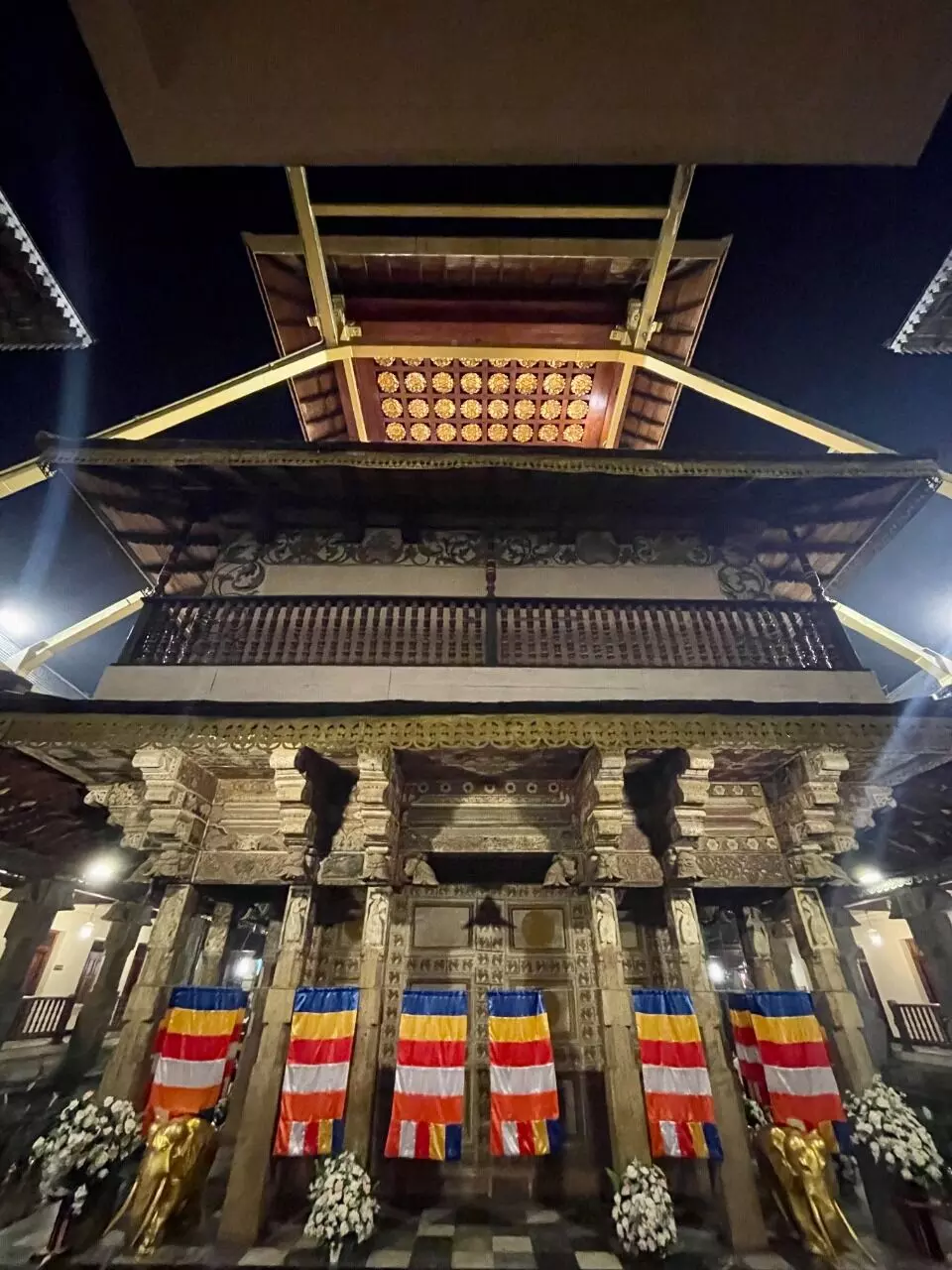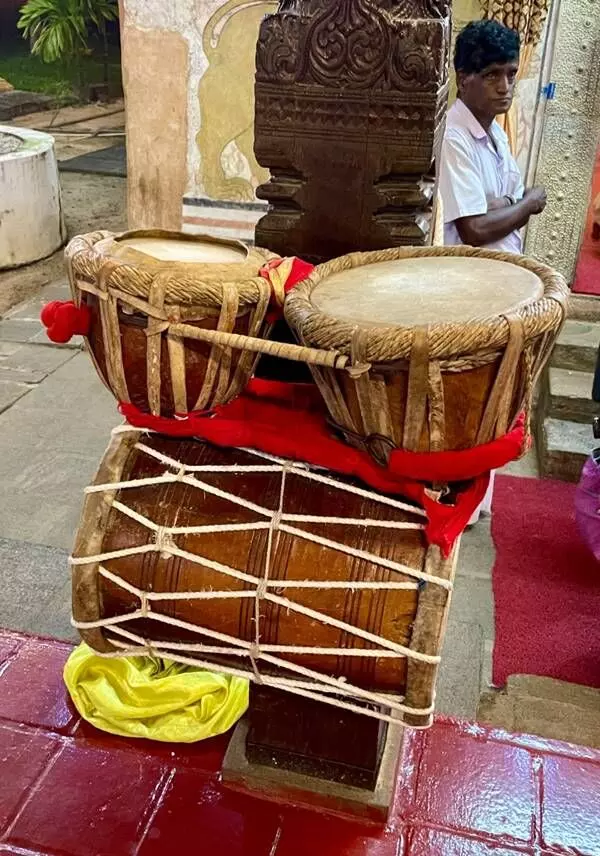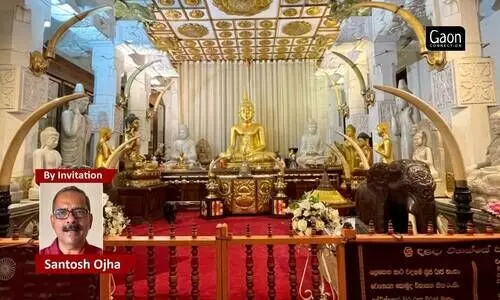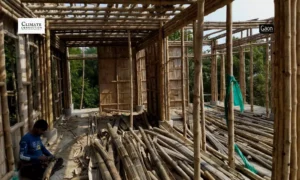The drummer bangs his twin drum set — the thammetamma — with the kadippuwa, drumming sticks. His two co-drummers join in while the fourth musician coaxes notes from his trumpet-like instrument, the horanawa.
Each of the musicians is in a white dhoti with a red cloth wrapped around his waist and a piece of white cloth around his head. The evening hewisi (hevisi) puja, or the musical offering to Buddha, is about to begin.
I am at Sri Dalada Maligawa, or the Temple of the Sacred Tooth Relic, at Kandy, Sri Lanka. It is a temple revered by Buddhists worldwide as it houses a priceless relic of Buddha, his left canine teeth. It is 6.15 pm, and the swelling crowds at the temple wait with bated breaths for the evening rituals to begin.
***
After Buddha’s Maha Parinirvana, somewhere around 450 BC (the exact time is uncertain), the tooth relic was in the custody of Kalinga monarchs (modern-day Odisha). The tooth relic of Buddha was brought to Sri Lankan shores in the fourth century AD by the Kalinga princess Hemamali who famously hid it in her hair for safekeeping during transit.

This ritual is to invoke God for adequate rainfall.
Buddhism was already flourishing in Sri Lanka; Ashoka, the Great’s son Mahinda, had brought it to this island around 250 BC. Sri Lanka also had a sapling from the Bodhi Tree, Bodh Gaya, brought by Mahinda’s sister, Sanghamitra.
The custodian of the Tooth relic was the King of Anuradhapura, who ruled the entire island. Ruling Sinhala kings, irrespective of their dynasties, have been custodians of the Relic historically.
Also Read: Rural getaways for a rejuvenating experience
The association of the Relic with the rulers became so strong that it was believed that whosoever had custody of the Relic ruled the country. Initially, the Relic was enshrined in the specially built Isurumuniya stupa. The Stupa still stands at Anuradhapura though the Tooth relic is not there anymore.
It moved with the change in the power centres, from Anuradhapura to Polonnaruwa to Dambadeniya, till it reached Kandy, where it now remains.
The Relic was enshrined in specially built structures close to the royal palace. At Kandy, a palace-like building (maligawa means a palace) called Sri Dalada Maligawa houses the Relic.
***
The drumming becomes more urgent and furious, and the crowd presses closer. Most wear white dresses, the colour to wear at a Buddhist shrine. We are bare-footed, of course, clutching our offerings to Buddha, lotus or blue lily flowers. The latter is the national flower of Sri Lanka.

Kandy comes alive during the ornate Esala Perahera Pageant. This celebration goes on for ten days, sometime in July or August. This ritual is to invoke God for adequate rainfall.
Some Buddhist monks, clad in saffron unstitched garments, are now visible, slowly walking towards us escorted by white-clad temple staff. The staff member in the front unlocks the silver-clad door facing us. The monks fold their hands and slowly walk through the door, which shuts behind them. The action then moves to the first floor of the temple.
***
We run up the flight of stairs and take our position in front of the chamber that houses the Relic. The crowds have decidedly increased, and there is some jostling to get a position right in front of the relic chamber door.
There is an ornate wooden carved railing serving as a barricade. A long table is placed outside the barrier for the devotees to place their floral offerings — the shut door glints behind the two impossible long and curved elephant tusks. The drumming on the ground floor continues relentlessly.
Also Read: Rajasthan Kabir Yatra 2022: A perfect jugalbandi of music, people, philosophy and nature
Two columns of devotees on either side of the relic chamber are waiting to be led to the room. They have taken a special permit for this purpose. I spot several non-Indian devotees, possibly from Southeast Asia or Japan.

The drum set is known as the thammetamma along with the kadippuwa — the drumming sticks.
The chamber door opens, and I have a quick view of the glittering stupa-shaped gold casket containing the Relic through the door before I get pushed sideways by others eager to cast their eyes on it. It reminds me a bit of the Tirupati temple, where the darshan of Balaji is as fleeting as the one I just had.
***
Kandy comes alive during the ornate Esala Perahera Pageant. This celebration goes on for ten days, sometime in July or August. This ritual is to invoke God for adequate rainfall.
A replica of the relic-bearing casket is placed on the head of an ornately caparisoned elephant. It is taken around in a procession around the temple area. Musicians, dancers, fire eaters, and whip crackers accompany the parade, witnessed by thousands of devotees and tourists from across the globe.
***
After that nano-second glimpse of the casket, I walk around the temple. A gallery shows the history of the Tooth Relic via a series of sixteen paintings. The image gallery features multiple statues of Buddha. There is a museum of sorts which displays various Buddhist memorabilia. A fascinating exhibit is the bound copy of Jataka Tales written on leaves and encased in a locked glass box.
I admire the ornately carved wooden beams and pillars of the temples. The Kandyan empire was known for wood carvings.
***
As I walk out of the Temple premises, the drummers still play their instruments with gusto. Devotees are still streaming in. And I reflect on the sights I had just witnessed; the profound veneration of a Buddha relic, as if the devotees were in the presence of the Buddha himself!
Santosh Ojha has worked 28 years in senior corporate roles. He retired early to chase his twin passions of travel and travel writing. Ojha is based in Bengaluru, Karnataka.




















